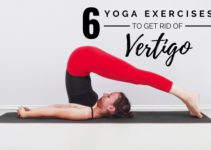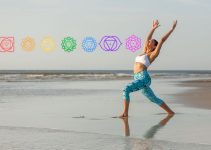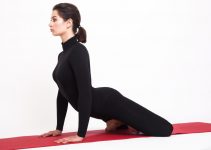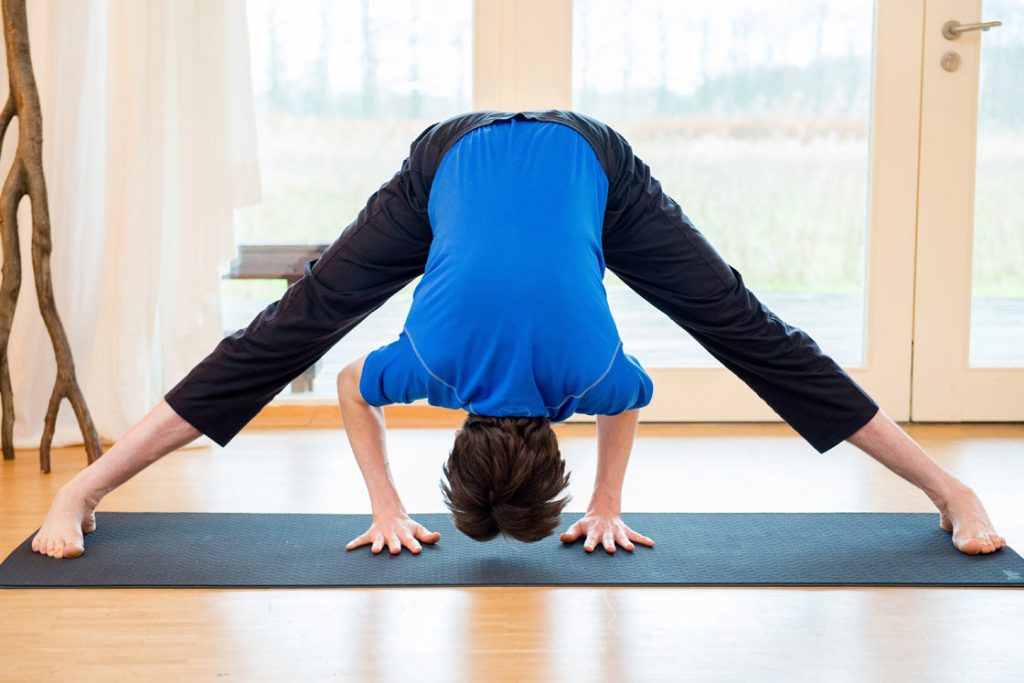
Wide-Legged Forward Bend is a beginner-level forward bending pose, that gives an amazing expansion to the torso with a deep stretch in hips and hamstrings.
In Sanskrit, it is known as Prasarita Padottanasana, the meaning of which can be broken down as follow:
- Prasarita – spread or expanded
- Pada – foot or leg
- Ut – intense
- Tan – to stretch
- Asana – pose
Thus it literally translates to “Feet Spread Intense Stretch Pose“.
After a lengthy series of standing pose or after jogging, walking or cycling, the exercise may feel profound and calming. It is a beneficial preparatory posture for full inversion postures such as headstand, shoulder stand, and handstand, among many others.
Strengthening the leg muscles is just one of the many benefits this pose brings. It also stretches the hamstrings, hips, calves, knees and lower back, which is important for maintaining flexibility and elasticity.
It’s also a pose to strengthen your core, as you need to tighten these muscles to maintain the bend and balance of your body.
The best thing about this pose is that with its 3 additional variations, it is versatile and can be performed by all exercisers.
It will be interesting to know that this pose is not among the traditional hatha yoga poses. It was introduced in the Iyengar school of yoga and was further incorporated in Ashtanga, vinyasa, and power yoga as a transition pose.
Let us have a look at this wonderful pose in detail.
Practice Guide for Wide-Legged Forward Bend
Preparatory Poses
- Adho Mukha Svanasana (Downward-facing Dog Pose)
- Uttanasana (Standing Forward Bend)
- Trikonasana (Triangle Pose)
- Utthita Tadasana (Five-Pointed Star Pose)
- Baddha Konasana (Bound Angle Pose)
Steps to Perform Wide-Legged Forward Bend
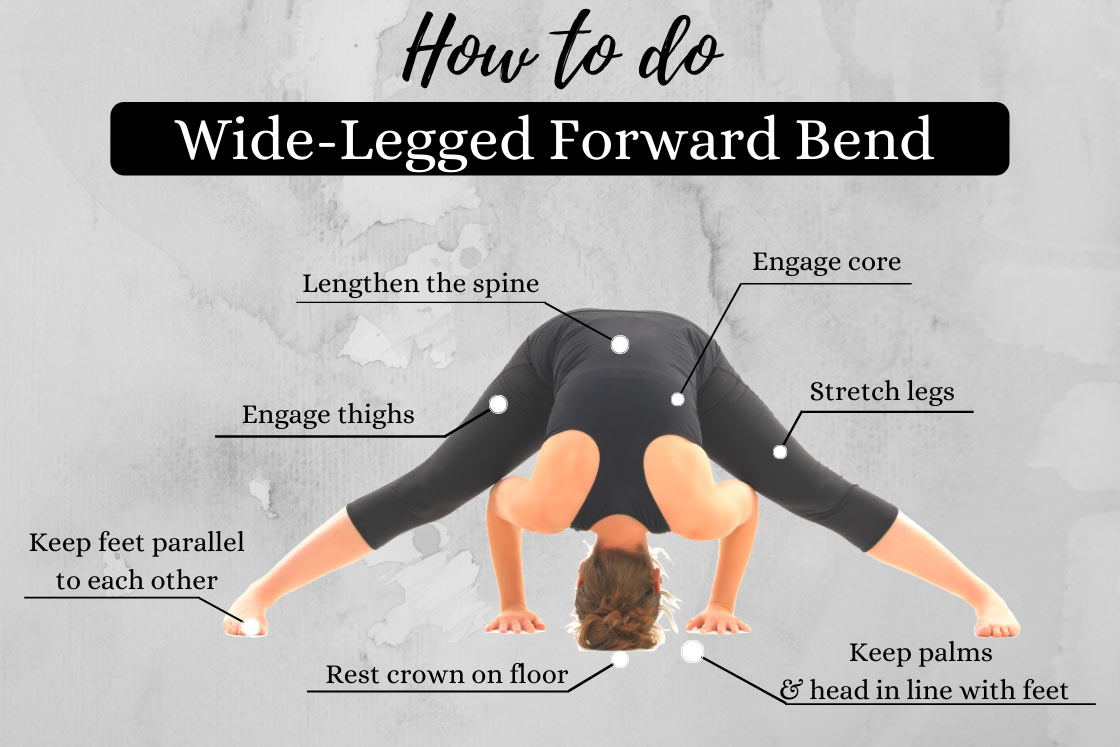
- Stand tall and straight on the floor in Tadasana (Mountain Pose) with your hands on your waist
- Spread out your feet about 3-4 feet apart. Keep your feet parallel to each other and spread the weight evenly on all corners of the feet.
- To align your feet’s edges with the edges of your mat, turn your toes slightly inward and your heels slightly outward.
- Lengthen your body by extending upward through the head’s crown.
- Gently bend from your hips instead of arching your lower back.
- Place your hands below your shoulders on the floor or blocks while maintaining a long back and an open chest. The palms should be in line with the feet, fingertips pointing forwards.
- To raise the hips toward the ceiling, press into the feet and lengthen the legs.
- As you exhale, stretch your torso more inward, bringing your stomach in closer and tightening your abdominal muscles.
- The crown of the head and palms should be resting on the floor. Maintain the weight of the body on your legs, not in the crown on the head.
- Hold this position for a minimum of 10-15 seconds.
- To release the asana, first, raise the head off the floor and then gently lift your torso. Slowly bring your feet together, and come back to Tadasana.
Beginner’s Tips
- The distance between your legs depends on your height and stability. Experiment with different variations of the distance to find the ideal position. Do not spread your legs too far apart as you may not be stable in the position.
- Lengthening your torso is much more crucial than placing the head on the floor. The moment you feel your back curving, you should stop bending further.
- Bend your knees to the degree necessary to get relief if your low back or the backs of your legs are tight.
- If your hips or lower back is stiff and tight, you can bend your body halfway such that your torso becomes parallel to the ground.
- If you are a beginner, you might feel difficult to place your head on the floor, so, you can put a yoga block, a stack of folded blankets, or a cushion to rest the crown of the head.
- Yoga blocks and blanket stacks can also be used to place your hands on them.
- Make sure your shoulder blades are pulling together and down your back because this pose tends to cause shoulders to drop.
- Make sure your head, palms, and feet are in line after bending.
Precautions and Contraindications
- Bend the torso from the hips, not from the waist.
- Perform this pose on an empty stomach as it significantly puts pressure on the abdomen. If you already had a meal, wait for at least 3-4 hours before performing this pose.
- Do not press your head on the floor. Simply rest it on the floor.
- If you have a recent injury, or sprain or have undergone surgery on your hips, thighs, back, neck, ankles, wrists, or knees, do not perform this pose.
- Avoid performing this inversion pose if you have blood pressure problems, vertigo, migraines, and/or headaches.
- People who have fibromyalgia or arthritis in the lower body should not perform this pose or proceed with extreme caution.
- Because of the deep extension of the spine, people with spinal conditions including herniated disks, advanced cervical- and lumbar-spondylosis, scoliosis, and kyphosis should avoid this pose.
- It is important to avoid such excessive inversions if you have heart disease or have had heart surgery.
- Women in the advanced stages of pregnancy must avoid this pose.
Variations of Wide-Legged Forward Bend(Prasarita Padottanasana)
There are three variations of wide-legged forward bend, which are mostly the hand positions. The above-mentioned steps are for Prasarita Padottanasana A.
These variations are somewhat more intense than the original as they increase the stretch.
Prasarita Padottanasana B
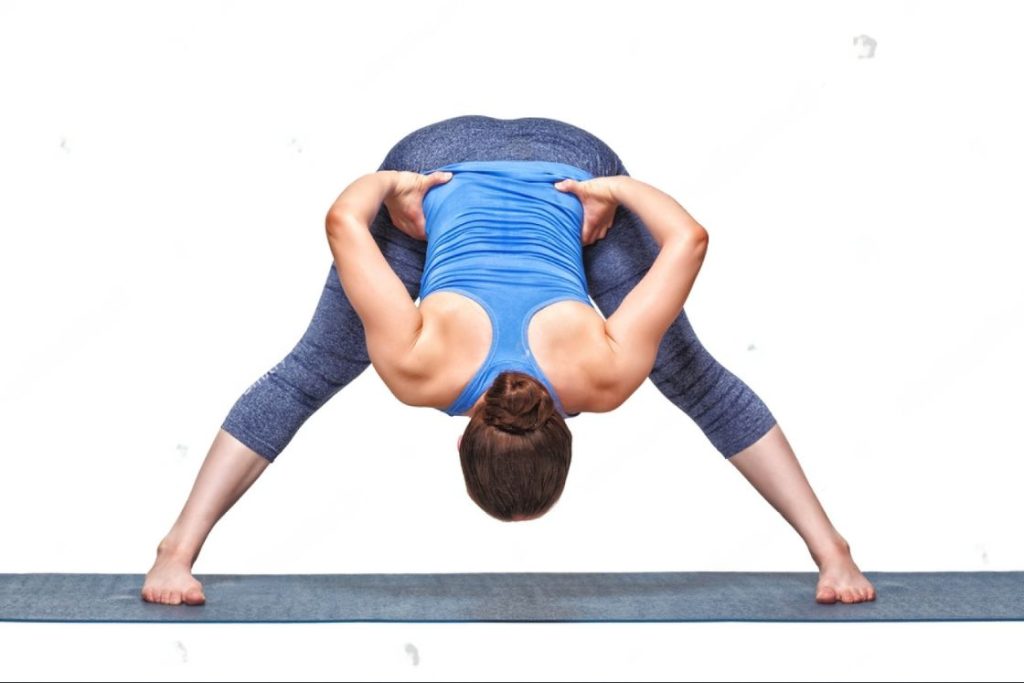
Once you have come into Prasarita Padottanasana A, lift your hands off the floor and place them on your waist. Rotate your shoulder outwards while placing the hands such that your elbows should be pointed to the front or same direction as your toes.
You can also use a strap in case you can bring your hands to the waist because of tight shoulders.
This variation gives additional stretch to your shoulders and further opens the chest.
Prasarita Padottanasana C
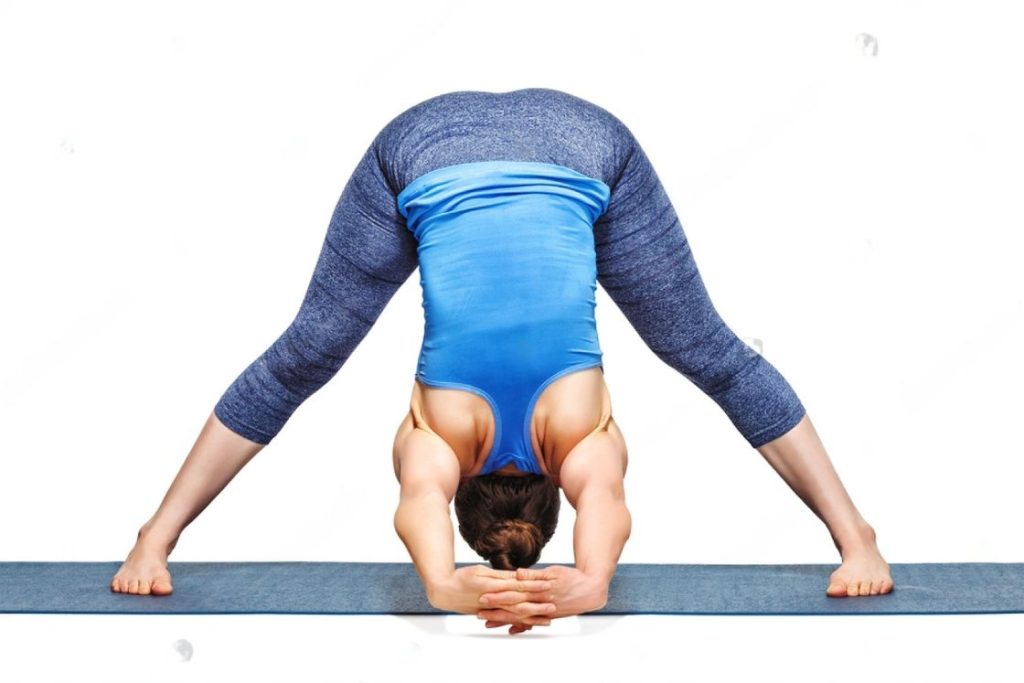
After coming to the final pose of Prasarita Padottanasana A, lift your hands off the ground and rotate your shoulder to bring your arms to the back. Interlock your fingers and point them in the same direction as your toes.
Try bringing the hands towards the ground if your shoulder, upper back, and chest allow. you can also try to take them towards your hips or else you can keep them raised.
This variation intensifies the stretch in your shoulders and upper back while expanding the chest. The arm placement – towards the ground or hips – will target the upper arm muscles.
Prasarita Padottanasana D
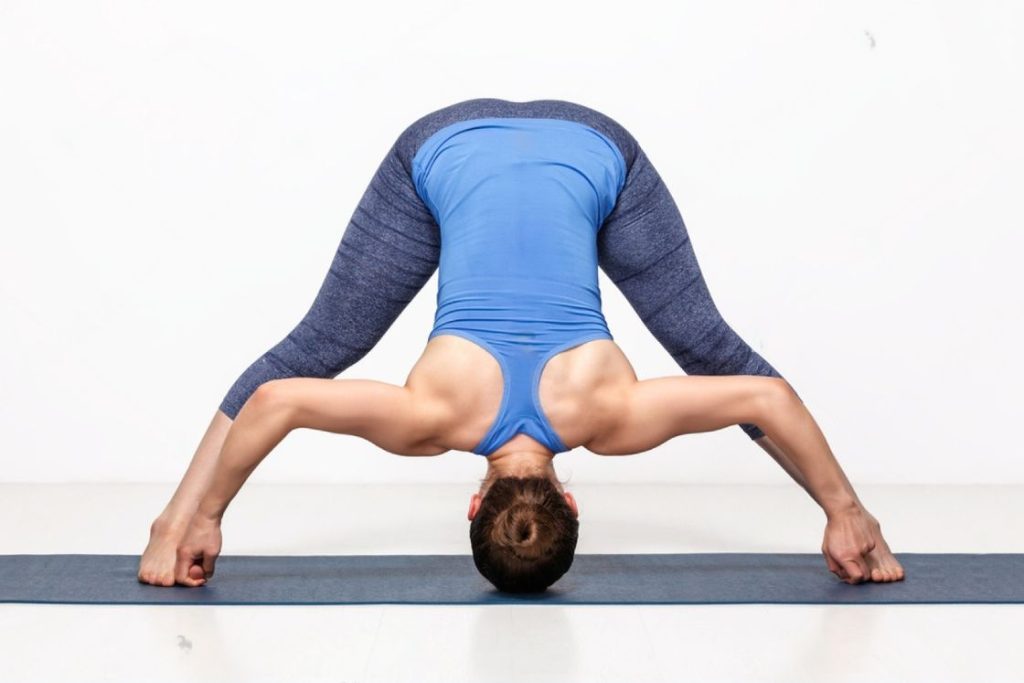
After getting into Prasarita Padottanasana A, move your palms to grab the big toes. Hold the big toe with the first two fingers and thumb.
Keep your arms in the same position as the original pose, just increase the distance between them to hold the toes. keep the elbows stacked on the wrists.
This variation will add extra stretch to your shoulders, upper back, upper arms, and chest.
Follow-Up Poses
- Paschimottanasana (Seated Forward Bend)
- Sirsasana (Head Stand)
- Utthita Parsvakonasana (Extended Side Angle Pose)
- Merudandasana (Spinal Column Pose)
- Garudasana (Eagle Pose)
Benefits of Wide-Legged Forward Bend
Prasarita Padottanasana combines the advantages of both forward folds and inversions. Your flexibility can speedily and significantly grow in this pose. The nervous system is calmed and soothed, and it helps the body and mind be ready for more challenging yoga positions and reflection.
Below are some of its benefits:
- Opens the hips and stretches the lower back muscles.
- Eliminates stress and stiffness in the hips and tones the muscles of the lower back.
- Acts to lengthen the spine and improve its flexibility and range of motion.
- Tones and massages the muscles of the trunk and abdominal organs, contributing to better digestion and metabolism.
- Increases elasticity, strength and mobility of the hips, hamstrings and quads as the legs are stretched wide.
- Tones and strengthens the calf and ankle muscles and improves their flexibility.
- Improves blood circulation to the head through the inversion.
- Eliminates stress, stiffness and tension in the neck and shoulders.
- Improves the flow of prana, which reduces.
- Promotes focus and concentration, as you need to ensure that your body is well balanced and stabilized.
- Relaxes the nervous system and gives a deep sense of relaxation and fulfillment.
- Relieves depression, anger and anxiety in the body due to improved blood flow to the brain.
